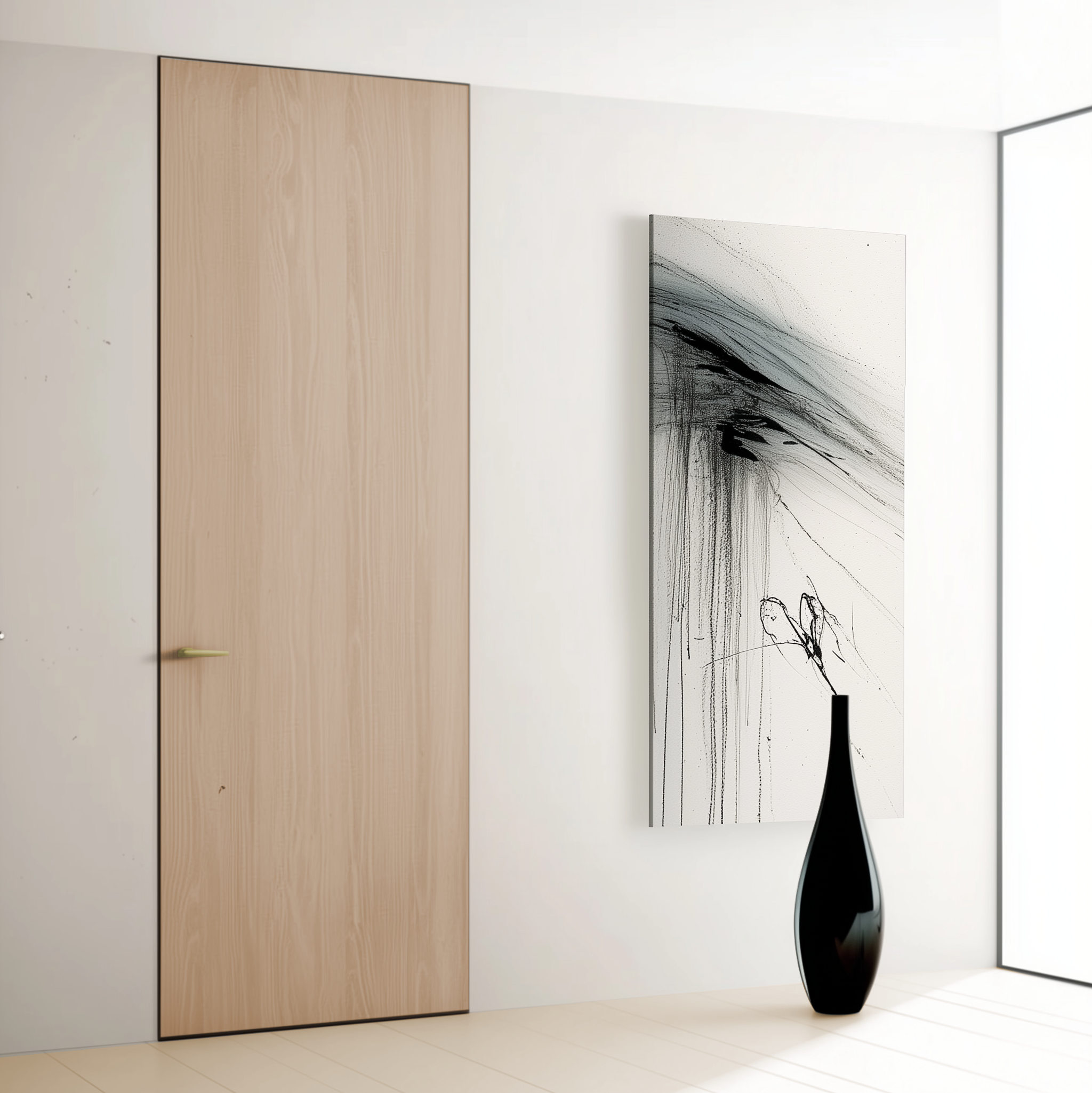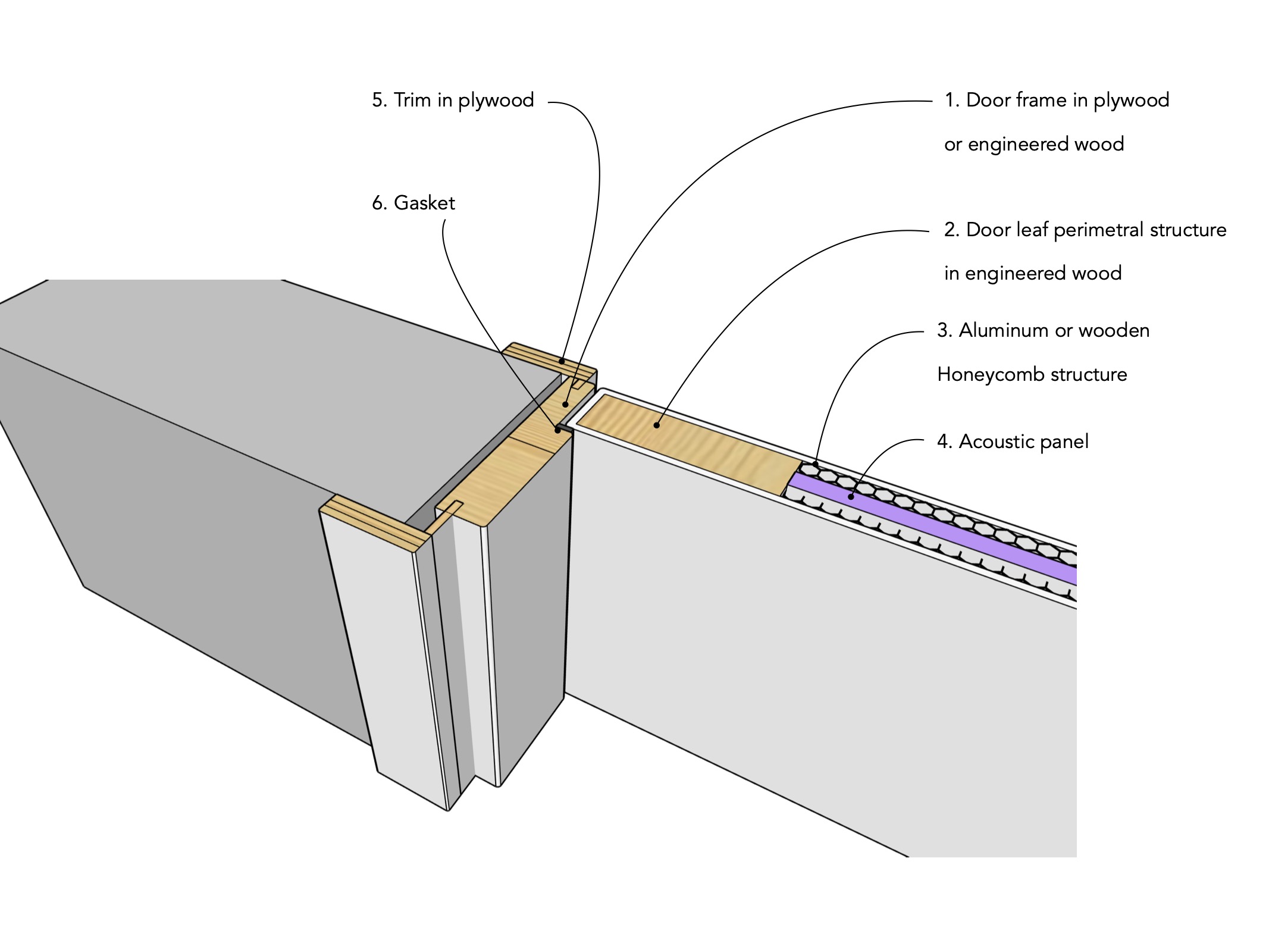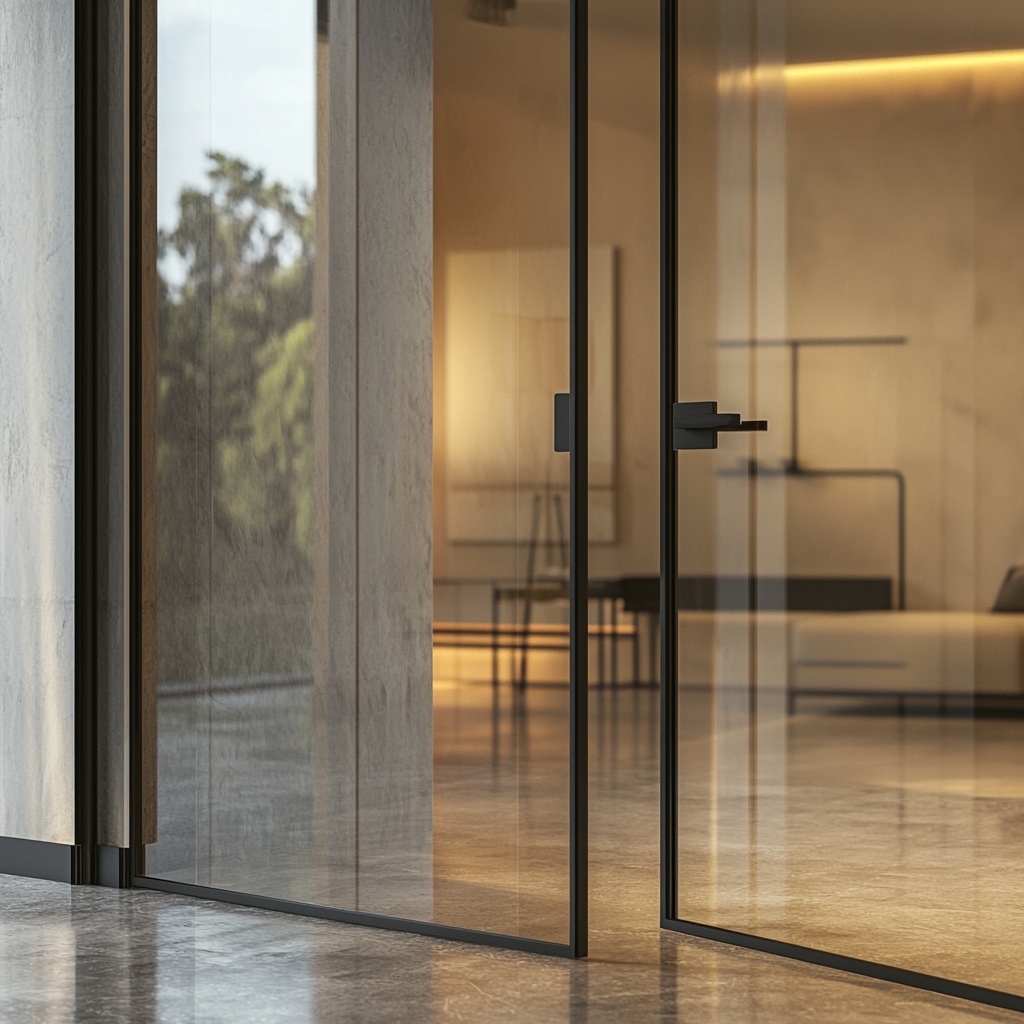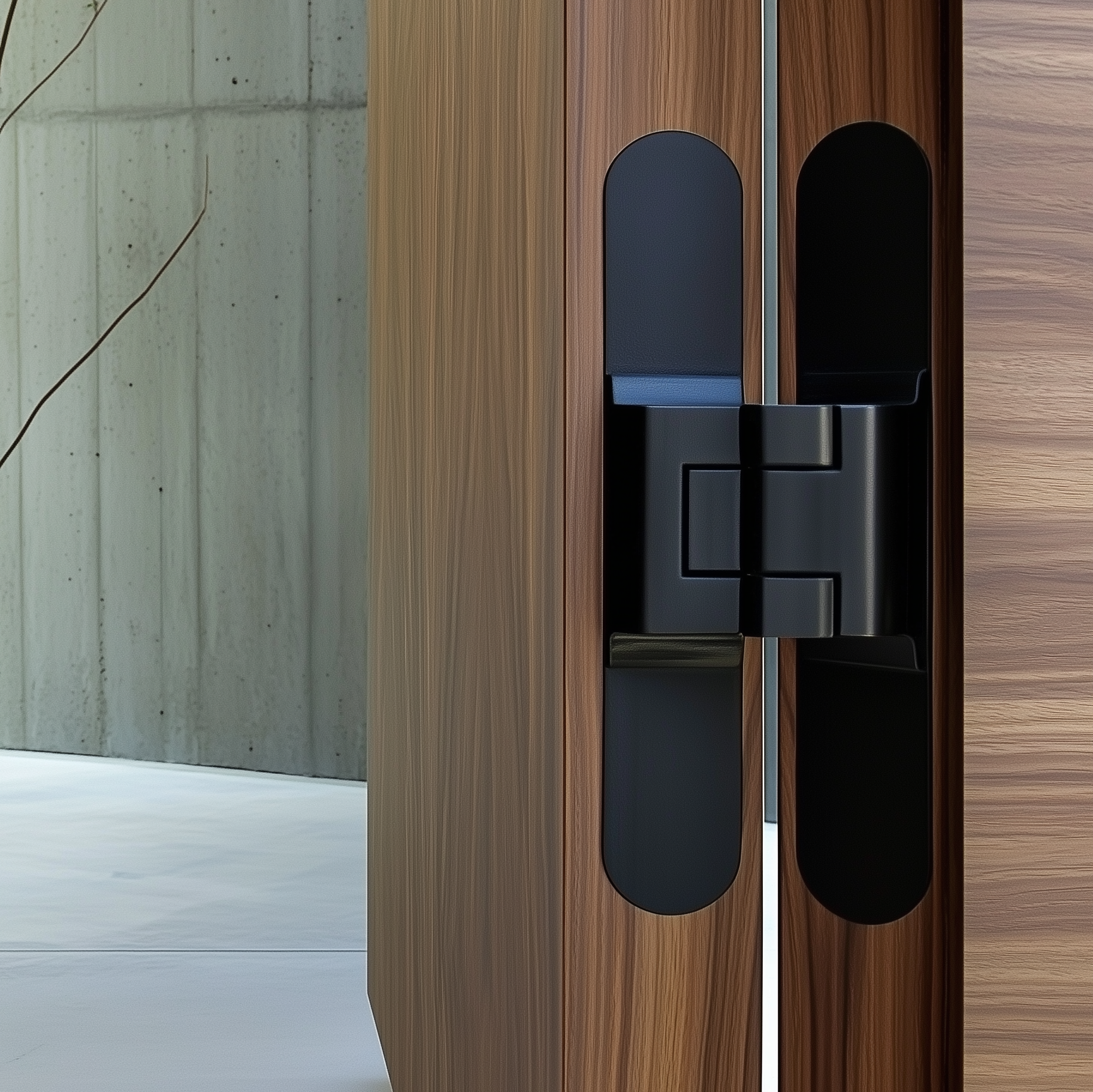An Intro Guide to Hinged Doors

Table of Contents
Doors as Design Element
An interior door is far more than a functional element. It defines the boundaries between spaces, shapes how rooms are perceived, and contributes to the overall architectural language of a project. Choosing the right door requires balancing design intent with technical requirements. When carefully designed and engineered, an interior door becomes an integral part of the architectural composition, enhancing both form and function.
Interior doors come in a variety of typologies, each offering distinct spatial and design qualities. Understanding their characteristics helps architects and clients choose the most suitable solution for each environment. Hinged doors are the most traditional and versatile type, suitable for both contemporary and classic interiors. They provide excellent acoustic performance and mechanical reliability. Pivot doors feature a central or offset pivot point, and can accommodate large panels and create a striking architectural statement. Another common solution are sliding doors. These are practical, space-saving elements that allows for flexible, fluid layouts. They are particularly well-suited to modern, open-plan interiors. Last but not least, we have pocket doors. They also feature a sliding mechanism, but differently from the regular sliding ones, they disappear into the wall cavity, maximizing usable space and providing an elegant, seamless transition between rooms.
This short guide deep-dives into hinged doors for interiors, exploring key aspects such as opening systems, construction methods, aesthetic styles, and practical design considerations that needs to be taken into account when selecting this type of product for a design project. While we wrote this piece based on our decade-long experience in the industry, the market is nevertheless in constant evolution, with new materials and technologies continuously emerging that could rapidly unlock new doors’ solutions. It is also to note that every project needs special consideration based on individual circumstances, and the elements mentioned in this guide not address your specific needs.
Hinged Doors
Hinged doors remain the most widely used interior door type due to their simplicity, performance, and adaptability.
High-quality hinged doors can provide excellent functionalities and performance. Translated into practice this means excellent acoustic insulation, airtightness, and smooth, reliable operation over time. Available in a broad range of materials and finishes, hinged doors complement both traditional and minimalist interiors with their extreme versatility. Their straightforward construction and installation also makes them a cost-effective choice that doesn’t compromise neither on look nor performance. When paired with modern concealed hinges or flush frames, hinged doors achieve a clean, contemporary look while maintaining structural stability. This reflects a high-degree of engineering precision.
The first aspect that is evaluated when choosing a door is without debate how it looks. Aesthetic is essential to make sure it integrates into a design concept.
Defining the Aesthetic
When it comes to aesthetic, the trim is definitely the major decision to make. Here there are two options: trim or trimless. This choice between trim and trimless door systems plays a key role in shaping the architectural expression of a space.

Doors with trim are classic solution that features a visible frame and casing that outline the door opening. This approach adds character and depth, making it ideal for traditional or transitional interiors.
On the opposite side, trimless or flush-to-wall doors, feature a minimalist configuration where the door aligns perfectly with the wall, eliminating visible frames. Achieving a flawless trimless installation requires precision engineering, high-quality hardware, and accurately aligned walls. The result is an elegant, understated door that seamlessly integrates with the architecture.
Materials and internal structures have a heavily influence how an hinged door’s aesthetic, its durability and its performance.
Structure and Materials
Interior hinged doors are defined not only by their design but also by the materials and construction methods used. Understanding the core structure helps architects and designers make informed choices about aesthetics, durability, and performance.
Solid wood doors are made entirely from natural timber and are available in various species such as oak, walnut, or ash. They are ideal for spaces where the warmth and authenticity of natural wood grain are desired. Typically, solid wood doors are finished in natural or stained wood tones rather than painted or lacquered. Given the material used, they are generally more expensive.
The use of solid wood carries its own advantages and disadvantages that needs to be considered when integrating this type of doors into the projects. When looking at aesthetic, the classic look surely complements very well traditional designs, but it does have limitations. In terms of customization, there are only a limited number of finishes to choose from, and the structure significantly restricts size options.
In terms of durability, solid wood doors can be long-lasting, high-performing products when properly maintained. The wood used can be sanded, refinished, and repaired multiple times. But at the same time, they are also very susceptible to humidity changes in the environment. These changes lead to expansion or contraction of the wood, causing the door to warp and thus affecting door stability during usage. While the solid wood structure offers excellent acoustic insulation between spaces, its substantial weight places ongoing stress on the hinges, ultimately reducing the lifespan of the hardware. Typical solid wood doors are also not inherently fire-rated.
Engineered wood doors have a solid core composed of different materials. Higher-quality models typically use hardwood plywood, while more economical options use MDF or particleboard. They are finished with materials such as lacquer, veneer, or laminate applied to the surface. This construction offers versatility, durability, and environmental benefits.
This construction lends itself to a wide variety of aesthetic possibilities, making engineered doors an adaptable solution for projects seeking both design flexibility and consistent performance. Their layered structure allows for an extensive range of surface finishes, though the internal core might introduce some limitations in terms of size and complex design customization. Although natural timber veneer can be used as a surface finish, it often cannot match the tactile authenticity of solid wood, particularly in rustic settings.
In terms of durability, engineered wood doors offer excellent dimensional stability, performing reliably even in environments where temperature and humidity fluctuate. Opposite to solid wood, their lighter weight eases the strain on hinges and hardware, contributing to smoother operation and longer-lasting installations. This very structure further grants them dimensional stability over time.
From an environmental standpoint, engineered wood makes efficient use of resources, as the core is usually made from poplar and fir, fast-growing timber species. This also results in less material waste during production compared to solid wood, which requires large slabs and generates significant offcuts.

Honeycomb-core doors feature a lightweight internal honeycomb structure made from materials such as cardboard, wood-based panels, or aluminum. The choice of core material influences the door’s weight, strength, sound insulation, and environmental impact, making these doors versatile for various functional and aesthetic needs.
This construction makes them highly adaptable in terms of appearance, allowing them to integrate seamlessly into a wide range of design concepts. They are compatible with a wider number of surface finishes, among which veneers, lacquers, and laminates. The flexible core composition allows significant customization of dimensions, particularly height and width, while maintaining stability. As a minor note, the lightweight nature that enhances versatility also means these doors may not provide the same sense of solidity or tactile presence as solid wood alternatives.
From a durability standpoint, honeycomb-core doors offer excellent dimensional stability over time, especially when aluminum cores are environments subject to humidity or temperature fluctuations. Similarly to engineered doors, the lightweight core simplifies door’s installation and guarantees flawless, performance, putting low stress on hinges and hardware. Nevertheless, their impact resistance is lower than that of solid-core or solid-wood constructions, making them less suitable for high-traffic or heavy-use areas where more robust doors are required.
Environmentally, honeycomb-core doors present clear advantages. Their production relies on significantly less raw material, often incorporating recycled cores, which contributes to a lower overall environmental footprint. This makes them a cost-effective and eco-conscious option for many interior applications.


Aluminum and glass doors are increasingly popular in modern interiors for their sleek, minimalist aesthetics and exceptional durability. These doors combine a strong yet lightweight aluminum frame with tempered or laminated glass panels, providing both style and performance. They are particularly suited to contemporary homes, offices, and commercial spaces where transparency, light, and clean lines are desired. The price point is generally higher than that of wooden-core doors, due to the materials used.
These doors offer a wide range of design possibilities as well as finishes and styles, making them extremely versatile. Aluminum frames can be powder-coated or anodized in various colours and finishes, while glass panels may be clear, frosted, tinted, or even decorative, making them adaptable to both minimalist and industrial-style interiors.
Aluminum and glass doors perform exceptionally well over time. Both aluminum and glass are inherently resistant to humidity and temperature fluctuations, ensuring long-term stability in environments where other materials might warp or degrade. The robust frame and reinforced glazing contribute to a reliable, durable solution. While tempered glass is strong, it remains vulnerable to strong impacts, and demands careful handling and professional replacement if damaged
From a sustainability perspective, these doors generally have a higher environmental footprint than wood-based doors. However, because aluminium is fully recyclable, the source of the aluminium and its recyclability at the end of its life can help mitigate this impact.

Hardware Functionality and Details
Visible Hinges are ideal for a rustic or traditional look, these hinges are easy to install and can add character to the door. However, they offer limited adjustability and generally have lower long-term durability compared to concealed options. Visible hinges, though often durable, are exposed to environmental wear and may require more frequent lubrication.
Concealed Hinges are perfect for a sleek, minimalist aesthetic, these hinges are hidden from view for a clean finish. They offer exceptional performance and durability with adjustability that is precise down to the millimeter, however professional installation is needed to ensure proper alignment and smooth operation.

Choosing the right handle and lock set ensures both ergonomic comfort and visual harmony. Modern designs often feature magnetic closures, which provide silent, smooth, and effortless operation while reducing wear on the frame and hinges over time.
TIP:
Precise hardware selection and proper installation are critical for long-term performance, alignment, and durability. This is particularly true for heavy or frequently used doors.
The hardware of a door is more than just a functional element: it defines how the door feels, operates, and complements the interior design. The type of hinge you select affects both the functionality and the style of your door.
Finishes and Customization
The finish of an interior door it defines the mood and character of a space. Selecting the right surface treatment ensures that doors harmonize seamlessly with the overall design language of the interior.
The range of surface options and finishes is nearly endless, but they generally fall into two main categories: pre-finished doors and site-finished doors.
Pre-finished doors are treated and completed directly at the factory under controlled, dust-free conditions, ensuring a level of precision and consistency that is difficult to achieve on-site. This process produces a uniform colour, texture, and surface protection, resulting in a finish that is not only visually superior but also more durable and resistant to wear, moisture, and UV exposure. Available finish options include wood veneers, lacquers in matte or glossy textures, glass panels, minimalist aluminum frames, and distinctive materials such as leather or metal surfaces for bespoke designs.
Site-finished doors are completed after installation, allowing for a fully integrated appearance with surrounding surfaces. This approach is ideal when continuity between wall and door is desired, such as plastered or wallpapered finishes that create a seamless visual transition.
Door finishes can unlock various customization possibilities in that they can be coordinated with cabinetry, flooring, or wall colours to achieve a cohesive interior aesthetic. Many details can also be personalized; for instance, handles and lock sets can be selected to match bathroom or kitchen fixtures, reinforcing design consistency throughout the project. For architects and designers, this level of customization allows doors to move beyond a functional role and become a refined, integrated component of the overall spatial composition.

Quality Indicators: What to Look For?
To conclude our journey into the world of interior hinged doors, there are numerous element that needs to be considered when selecting an hinged door. To make the best decision for a design project, it is paramount to evaluating a door’s craftsmanship and performance by paying attention to key quality indicators.
A high-quality door system maintains dimensional stability and alignment under variable environmental conditions. The leaf and frame should resist torsion and deflection, ensuring the door remains true over time.
Specifying doors made from high-quality, well-engineered materials ensures durability, acoustic isolation, and impact resistance. Precision-milled frames with minimal tolerance deviation, promote tight junctions and accurate seating within the wall system. Prefer trims made from plywood or engineered wood rather than MDF to improve resistance to impact and moisture.
Premium systems offer micro-adjustability during installation. Adjustable hinges and precision-machined hardware allow millimeter-level calibration to achieve optimal leaf-to-frame alignment.
A high standard of finishing is reflected in uniform edge banding, surface continuity, and precise hardware integration. Opt for doors that are pre-finished at the factory if there is no need for plastering or wallpapering. Hardware should perform smoothly under repeated use; concealed systems and silent latch mechanisms are key indicators of advanced engineering.
Continuous, high-quality gaskets improve acoustic ratings, minimize air infiltration, and enhance user comfort. They also contribute to perceived quality by reducing vibration and impact noise upon closure.
A magnetic lock set ensures silent engagement and flush alignment, providing a minimalist aesthetic with reliable functionality. For high-spec interiors, these systems reinforce both tactile quality and visual coherence.The finish of an interior door it defines the mood and character of a space. Selecting the right surface treatment ensures that doors harmonize seamlessly with the overall design language of the interior.

Still exploring how to design the perfect door system for your next project?